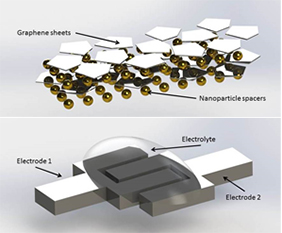3D-nanoprinted supercapacitors
Additive manufacturing (AM) to create an optimal nanostructure of graphene-based electrodes.
Details
- Period: 2019-01-01 – 2024-12-31
- Funder: Swedish Research Council
About the project
Supercapacitors belong to the top candidates for the next leap in energy storage technology, with a theoretical performance in line with the currently best batteries for applications in e.g. electric cars. In the present project, we will use additive manufacturing (AM) to create an optimum nanostructure of graphene based electrodes and a particular 3D-nanoprinting process, electrowriting of graphene ink, will be developed. The key to reach the envisioned performance is a combination of colloidal graphene chemistry and nanoprinting process knowledge. The project team is ideally suited to develop all AM steps from graphene ink formulation to printing a controlled electrode nanostructure where all steps are important to reach both high energy density and high power density.
The electrowriting allows for nanometer controlled placement and the supercapacitor will be built as an interdigitated electrode pattern with alternating sub-µm sized graphene sheets and Au nanoparticle spacers. Various ink and printing factors will be studied and optimized to create an ideal nanostructure. One of the scientific challenges is related to the complex colloidal properties of graphene dispersions and the demand for high layer coverage with a minimum of overlap between the sub-µm sized graphene sheets. Another important challenge is to print multilayered structures with optimum interlayer spacing and pore structures for the ions in the selected electrolyte.

Schematic electrode arrangement with alternating graphene sheets and spacers (top) and evaluation structure (bottom) with interdigital electrodes. Note: the nanoparticle spacers are not to scale.
Partner Organizations
- Department of Materials Science and Engineering, UU
- Department of Chemistry - BMC, UU
